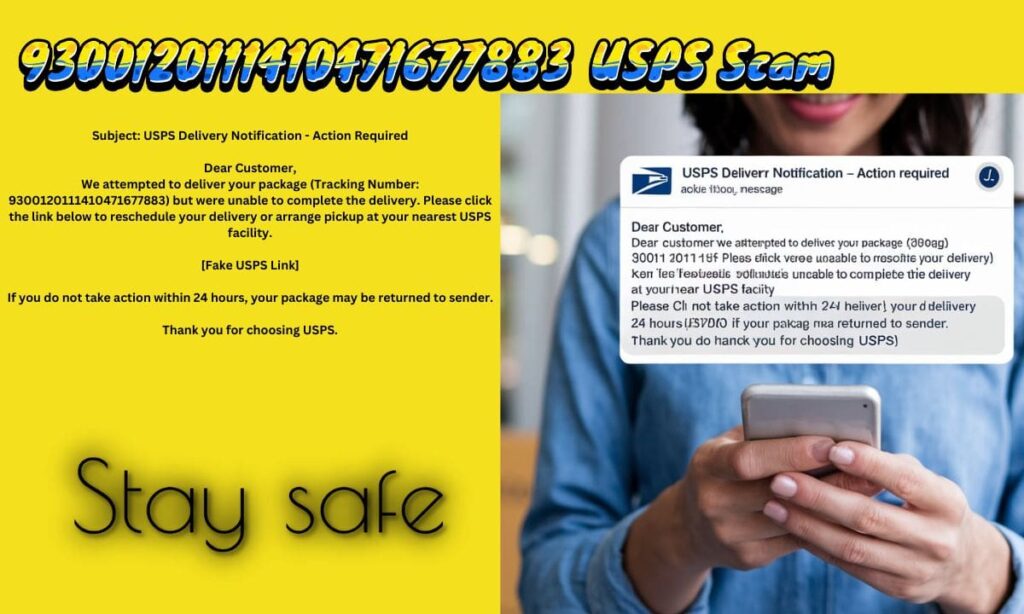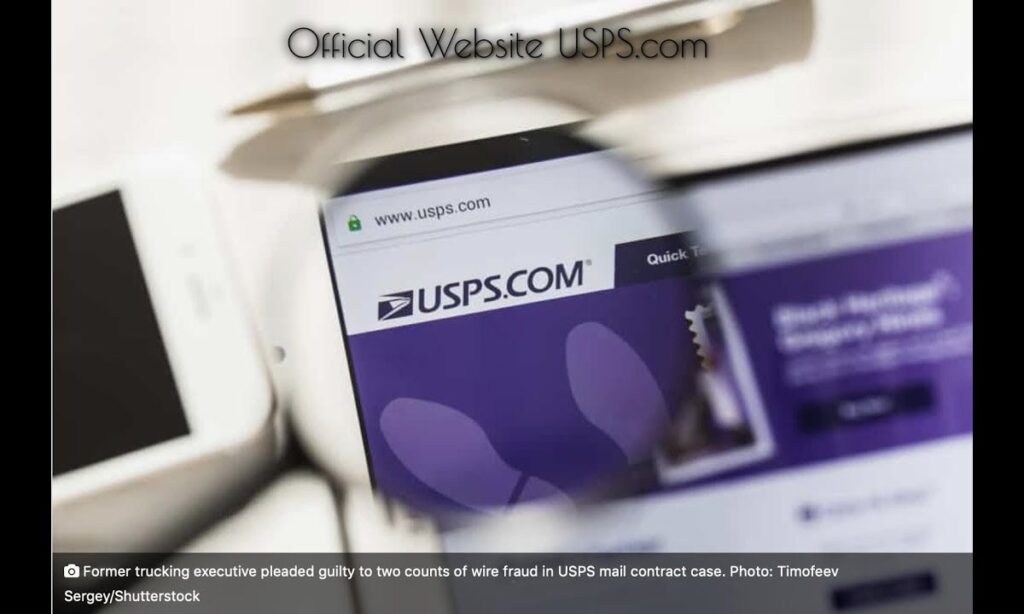In today’s digital age, online scams have become increasingly sophisticated, targeting unsuspecting individuals with alarming precision.
One such scheme that’s been making waves across the United States is the 9300120111410471677883 USPS scam.
This fraudulent operation exploits the trust Americans place in the United States Postal Service (USPS) to steal personal and financial information. Let’s dive deep into this scam, uncover its workings, and arm ourselves with the knowledge to stay safe.
Introduction
The 9300120111410471677883 USPS scam is a prime example of how scammers are evolving their tactics to exploit our daily routines. By leveraging the ubiquity of package deliveries and our reliance on tracking numbers, these fraudsters have crafted a scheme that’s fooling even the most cautious consumers.
The scam’s success lies in its ability to create a sense of urgency while appearing legitimately associated with the USPS.
As we navigate through the intricacies of this scam, remember that knowledge is your best defense. By understanding how the 9300120111410471677883 USPS scam operates, you’ll be better equipped to protect yourself and your loved ones from falling victim to this and similar phishing scams.
How the 9300120111410471677883 Scam Begins

The journey into the 9300120111410471677883 USPS scam typically starts in your inbox or on your phone. You receive an email or text message that appears to be from the USPS, informing you of a missed package delivery.
The message includes a tracking number – in this case, 9300120111410471677883 – and urges you to take immediate action to retrieve your package.
Here’s what a typical scam message might look like:
Subject: USPS Delivery Notification – Action Required
Dear Customer,
We attempted to deliver your package (Tracking Number: 9300120111410471677883) but were unable to complete the delivery. Please click the link below to reschedule your delivery or arrange pickup at your nearest USPS facility.
[Fake USPS Link]
If you do not take action within 24 hours, your package may be returned to sender.
Thank you for choosing USPS.
This message plays on several psychological factors that make it particularly effective:
The Psychological Tactics Behind the 9300120111410471677883 Scam
- Urgency: The scam creates a sense of immediacy, suggesting that failure to act quickly could result in losing your package.
- Curiosity: Most people aren’t expecting a package, but the possibility of a surprise delivery is enticing.
- Authority: By impersonating the USPS, the scam leverages the trust people have in official government services.
- Fear of loss: The threat of the package being returned taps into our aversion to missing out on something potentially important.
Why the 9300120111410471677883 Scam Is So Convincing
The 9300120111410471677883 USPS scam is remarkably convincing due to its attention to detail:
- Official appearance: The emails and websites used in the scam often perfectly mimic official USPS branding and design.
- Plausible scenario: Missing a package delivery is a common occurrence, making the premise of the scam relatable.
- Use of real-looking tracking numbers: The tracking number 9300120111410471677883 is formatted to resemble genuine USPS tracking numbers.
The Nationwide Impact of the 9300120111410471677883 Scam
While exact figures are hard to come by, the Federal Trade Commission (FTC) reports that phishing scams, including those impersonating the USPS, have seen a significant uptick in recent years.
The 9300120111410471677883 USPS scam has affected thousands of Americans, leading to financial losses and compromised personal information.
“In 2020 alone, the FTC received over 2.1 million fraud reports from consumers, with imposter scams being the most common type of fraud reported.” – FTC Consumer Sentinel Network Data Book 2020
The Role of the Fake Tracking Number 9300120111410471677883
The tracking number 9300120111410471677883 plays a crucial role in lending credibility to the scam.
Here’s why this number is so effective:
- It follows the general format of USPS tracking numbers (usually 20-22 digits).
- The prefix “9300” is commonly used in legitimate USPS tracking numbers.
- The length and complexity of the number make it seem official and hard to guess.
Scammers generate these fake tracking numbers using algorithms that mimic the structure of real USPS tracking numbers.
This attention to detail makes it difficult for the average person to distinguish between a legitimate tracking number and a fraudulent one like 9300120111410471677883.
Recommended Blog: How Many Days Until Christmas 999999999999
The Fake USPS Website: A Well-Designed Trap

If you click the link in the scam email or text, you’re directed to a website that looks strikingly similar to the official USPS site. These fake websites are meticulously crafted to mimic the real USPS website, often including:
- The official USPS logo and color scheme
- Similar layouts and navigation menus
- HTTPS encryption (indicated by a padlock icon in the browser)
However, there are usually subtle differences that can help you spot a fake:
- The URL might be slightly off (e.g., usps-delivery.com instead of usps.com)
- There may be minor spelling or grammatical errors
- The site might ask for more information than the real USPS would require
The Information Requested by the Scam
Once on the fake USPS website, you’re typically asked to provide personal information to “verify your identity” or “confirm delivery details.”
The types of information requested often include:
- Full name and address
- Date of birth
- Social Security number
- Driver’s license number
- Credit card information (including CVV)
- Bank account details
This level of detail goes far beyond what the USPS would ever require for a simple package delivery, which is a major red flag.
How the 9300120111410471677884 USPS Scam Works
Let’s break down the step-by-step process of how this scam operates:
1. Crafting Fraudulent Notifications
Scammers create convincing emails or text messages that mimic official USPS communications. They use USPS logos, similar formatting, and urgent language to make the messages seem legitimate.
2. Including Fake Tracking Numbers
A fake tracking number like 9300120111410471677883 is included to add an air of authenticity. These numbers are generated to look like real USPS tracking numbers.
3. Directing to Highly Convincing Phishing Sites
The messages contain links that lead to carefully designed phishing websites. These sites often use HTTPS encryption and mimic the official USPS website in appearance and functionality.
4. Stealing and Exploiting User Data
Once a victim enters their personal information on the fake site, scammers collect and store this data. This information can be used for identity theft, financial fraud, or sold on the dark web.
5. Spreading Malware
In some cases, these phishing sites may also attempt to install malware on the victim’s device, giving scammers even more access to personal data.
6. Perpetuating Additional Scams
With the stolen information, scammers can conduct further fraudulent activities, such as opening credit cards, taking out loans, or selling the data to other criminals.
Is 9300120111410471677884 a Fake USPS Tracking Number?
While we’ve been focusing on 9300120111410471677883, it’s worth noting that scammers often use variations of this number. 9300120111410471677884 is another example of a fake tracking number that follows the same pattern.
Typical Scam Format
Fake USPS tracking numbers often follow this format:
- Start with “9300” (a common USPS prefix)
- Contain 20-22 digits
- May include repeating number patterns
Warning Signs of a Fake Tracking Number
To spot a fake tracking number like 9300120111410471677884, look out for:
- Numbers that don’t yield results on the official USPS tracking page
- Tracking numbers sent in unsolicited emails or texts
- Numbers that don’t match the format of recent legitimate USPS tracking numbers you’ve received
Identifying the Signs of the 9300120111410471677883 Scam
To protect yourself from the 9300120111410471677883 USPS scam and similar phishing attempts, be on the lookout for these red flags:
- Unsolicited messages about unexpected packages
- Pressure to act quickly or face consequences
- Requests for sensitive personal or financial information
- Links that lead to websites with URLs different from usps.com
- Poor grammar or spelling in official-looking communications
- Threats about packages being returned or additional fees
Protecting Yourself from the Scam
Here are some best practices to stay safe:
- Never click on links in unsolicited emails or texts about deliveries
- Verify tracking numbers directly on the official USPS website
- Use two-factor authentication on all your important accounts
- Keep your software and antivirus programs updated
- Be skeptical of any message creating a sense of urgency
What to Do If You’ve Fallen Victim to the Scam
If you suspect you’ve fallen for the 9300120111410471677883 USPS scam:
- Contact your bank and credit card companies immediately
- Place a fraud alert on your credit reports
- Change passwords for all your online accounts
- Monitor your accounts for any suspicious activity
- Consider freezing your credit to prevent new accounts from being opened in your name
Reporting the 9300120111410471677883 Scam
Reporting the scam is crucial for preventing future victims. Here’s where to report:
- USPS: Forward suspicious emails to spam@uspis.gov
- FTC: File a complaint at ftc.gov/complaint
- FBI: Submit a tip to the Internet Crime Complaint Center (IC3)
Educating Others About the Scam
Spread awareness by:
- Sharing information about the scam on social media
- Discussing online safety with friends and family
- Participating in community cybersecurity awareness programs
The Future of Scams Like 9300120111410471677883
As technology evolves, so too will scams. Future trends may include:
- More sophisticated AI-generated phishing messages
- Increased use of deepfake technology in scam videos
- Exploitation of emerging technologies like augmented reality
Taking Control of Your Online Security
Empower yourself with these security measures:
- Use a password manager to create and store strong, unique passwords
- Regularly review your privacy settings on social media
- Be cautious about the information you share online
- Consider using a virtual private network (VPN) for added security
The Role of Technology in Fighting Scams
While technology enables scammers, it’s also our ally in fighting fraud:
- AI-powered email filters are becoming better at detecting phishing attempts
- Browser extensions can help identify fraudulent websites
- Banks are implementing advanced fraud detection systems
See More Blog: Among Us Unblocked: Ultimate 2024 Guide to Free Gaming
Frequently Ask Questions (FAQ’s)
Is this a real tracking number?
No, the tracking number “9300120111410471677883” is part of a scam designed to trick recipients into providing personal information.
How to identify a fake USPS tracking number?
Check the tracking number on the official USPS website; if it doesn’t return valid package details, it’s likely a fake.
Does the USPS charge for redelivery?
No, USPS does not charge for standard redelivery services. Be cautious of any messages asking for payment for redelivery.
Is my package tracking legit?
To verify if a package tracking number is legitimate, enter it directly on the official USPS tracking website.
How to tell a fake UPS tracking number?
Fake UPS tracking numbers often appear invalid on the official UPS website or come from suspicious sources. Always verify on USPS.com.
Conclusion
The 9300120111410471677883 USPS scam is a stark reminder of the evolving threats in our digital world. By staying informed, vigilant, and proactive about our online security, we can protect ourselves and our communities from falling victim to such sophisticated schemes.
Remember, if something seems too urgent or too good to be true, it probably is. Always verify, never rush, and prioritize your personal and financial security in all online interactions.
Stay safe, stay informed, and let’s work together to outsmart the scammers.

SwaggerDiary.com is managed by an experienced team dedicated to delivering insightful articles, engaging content, and valuable resources across various topics.








